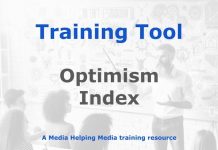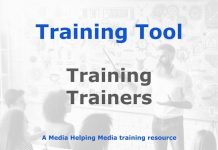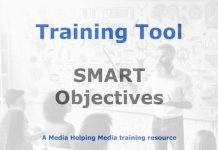
Thorough research is the essential if you are to deliver high-impact media training. Never accept a brief from media managers without question – they could be wrong and often are.
Superficial media training, carried out following inadequate training needs assessment, could damage the business and will waste your time and the time of those you are expected to help.
1: Understand the needs of the business
Establish what senior media managers want to achieve and then question it. A good trainer will never accept a training brief without scrutinising it first. Your first job is to check whether the company bosses are on the right track.
You will need to spend at least one day talking through the expected ROI (return on investment) of the training and ensure that all management expectations are fully tested and grounded in realistic and relevant business deliverables.
Ask the following:
- What is the current situation?
- What problems exist?
- What are the opportunities?
- What is the required, ideal situation?
- What new knowledge, skills or attitudes are desired?
2: Clarify the importance of your intervention
Don’t accept a training brief based on a superficial training needs assessment that bears no relation to the overall needs of the business.
You MUST carry out point 1 (above) first. If the company doesn’t agree to that, don’t accept the brief.
To do so is a recipe for disaster. It’ll waste your time and the time of those you are training.
It will also lead to resentment and disillusionment if staff members are trained in skills they may never be encouraged to put into practice. See point 4 below.
3: Clarify the business objectives
What objectives have been set for staff? Are they being met? If not, why not? Where is the blockage? Are objectives focused on the same expected ROI as expressed in point 1 (above)? Are the objectives flexible and can they be changed if needed?
Be aware that the main blockage may be at the top; you may find staff further down the food chain have a much greater vision for the business need than those in the board room.
Are the objectives being set the right objectives? Do they include corporate, unit and personal objectives? Do all three make sense?
Are they SMART? Specific, measurable, achievable, realistic and when do they need to be met (time)?
Ensure you understand:
- Corporate objectives.
- Unit objectives.
- Individual objectives.
4: Watch, listen and absorb
Ensure you are given enough time to talk to all levels of staff before you design your training plan (Step 2).
You will need to watch them in action to get an understanding of the issues you face and the needs they have.
You will need to talk to them to find out firsthand what it is like to work in the company.
Ask if you are allowed to take pictures of the newsroom and the workflows (they will come in useful in the design phase).
Then you need to talk to those they report to and those who report to them.
You need to immerse yourself totally in the day-to-day running of the business, particularly in the area in which you are being asked to offer training.
The usual journalistic questions of who, why, when, where, what and how are useful here.
5: Challenge all assumptions
It is important that everything is challenged and questioned at this stage. Do not accept any statements about why things are the way they are, or what the perceived needs are without thorough scrutiny.
If you don’t question, you may end up introducing training that compounds the problem rather than moves the company forward.
The training consultant should be one of the key players in a media business. You are dealing with one of the media organisation’s most precious resources – its staff – and you are working for the key stakeholders (who are not always right).
You need to understand their motives, both business and personal. You need to be aware of any internal pressures.
You also need to ensure that those commissioning the training understand the needs of the audience.
Don’t presume they have kept up to speed with changing audience behaviour.
6: Review and assess what already exists
Before you start to introduce new thinking, examine what already exists.
What training plans have been tried in the past? Did they work? If not, why not? How could they have been better? How were they received? What did the staff think? What did their managers think?
There is absolutely no point in serving up the same again if the previous training failed.
You will have been hired to move the company and its staff forward, not help them stand still, or worse take then a step back.
7: Skills audit and questionnaire
A neat way of finding out a lot of information quickly is to prepare a skills audit for all staff to complete.
Be sure to get permission from the line managers first, and make it clear that confidentiality and privacy will be respected.
The skills audit will assess what people already know and what they need to know.
It is helpful if their line manager is involved in this process. Download our sample skills audit here free of charge and change it to your needs.
You might also want to send them a learning questionnaire to try to establish what type of person they are.
Once completed you will know whether they are activists (doers), reflectors (who review), theorists (who conclude) or pragmatists (who plan).
The Learning Style Questionnaire (LSQ) developed by Honey and Mumford (1986) is one of several measures of individual learning style.
You can try the LSQ via this link to MINT human resources.
8: Talk to competitors and the audience
Don’t just take what you are told inside the company at face value. Go out and test it.
Of course, you will need to be discreet, but you will need to find out what the audience feels about the media organisation and how it is viewed by competitors.
Advertising agencies are also a good source of information here. They will know if the media business you have been asked to help is focused on audience need.
You can’t really have too much information at this stage. You can always discard material, but you will need to justify every element in the design of your training plan, if you are to convince management (and the staff you are training) that your approach makes sense for the company and for them.
9: Be prepared to stand your ground
There are many reasons why a company may want to introduce training.
It could be a box ticking exercise aimed at trying to keep the HR (human resources) department or the unions happy, or it could be tokenism because ‘it’s the done thing’.
You will soon find out. If management are not really serious it will become obvious fairly soon. That is why it is important to challenge all assumptions and question all reasoning.
If, at the end of this research period you feel there is no real desire for change be bold enough to pull out.
To continue and to deliver training that is irrelevant and which the management have no intention of implementing in the day-to-day working of the media business will damage your reputation.
It’s also totally pointless, boring and counter-production. Just don’t do it.
10: Remain professional and on good terms with stakeholders
If all goes well, you will be designing, delivering and then evaluating the training you have just been researching.
So let’s presume you research well, you will then need to design the training. At that point you will be going back to the stakeholders for sign-off. Better you are on speaking terms at that point.
After sign-off you will deliver and then, perhaps one of the most crucial points of the process, you will evaluate.
Once you have done that you will report back. This is also where you will need to have excellent relationships with the stakeholders because you are bound to have some valuable information to share – and some of it may be hard for some of them to stomach.








